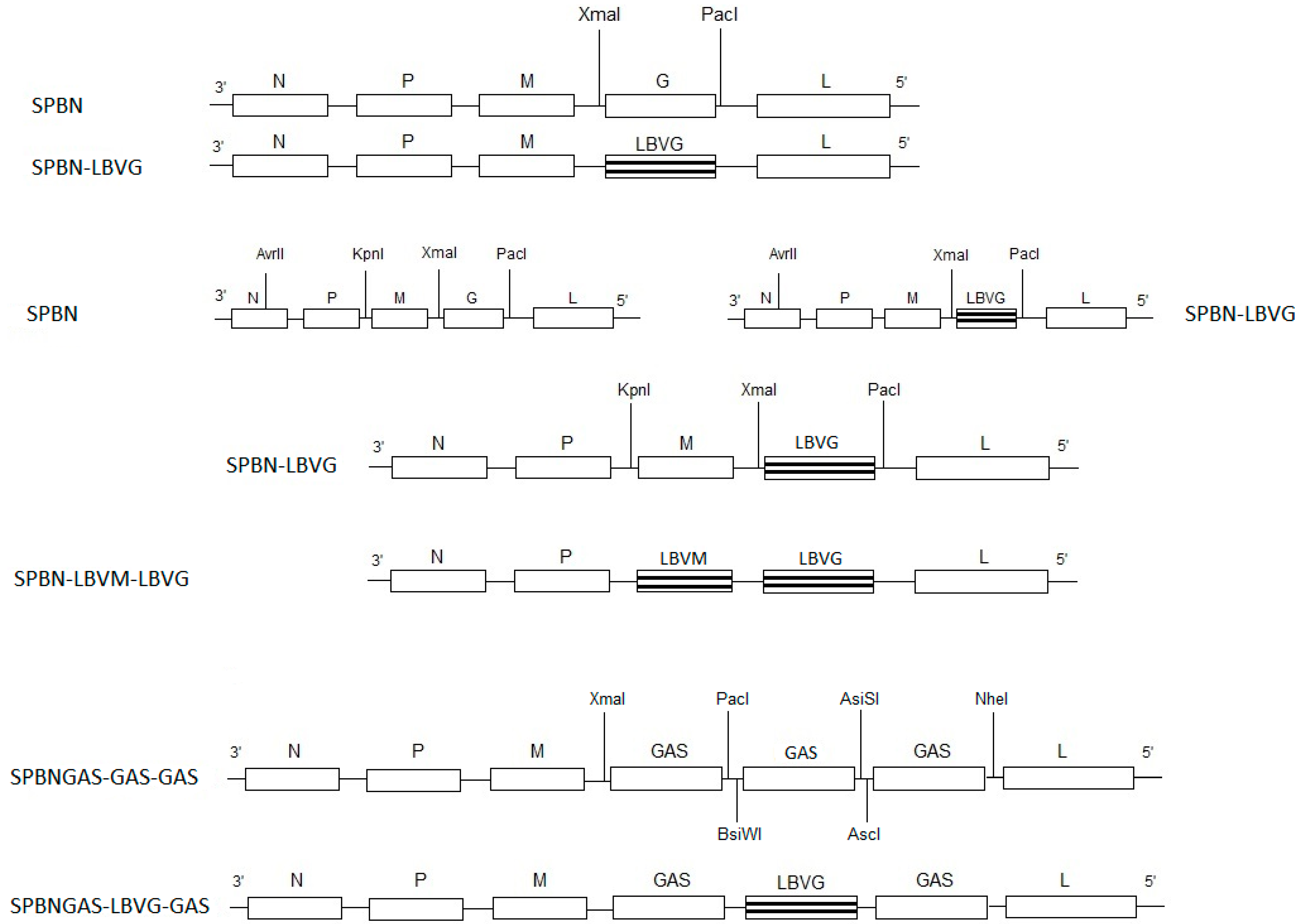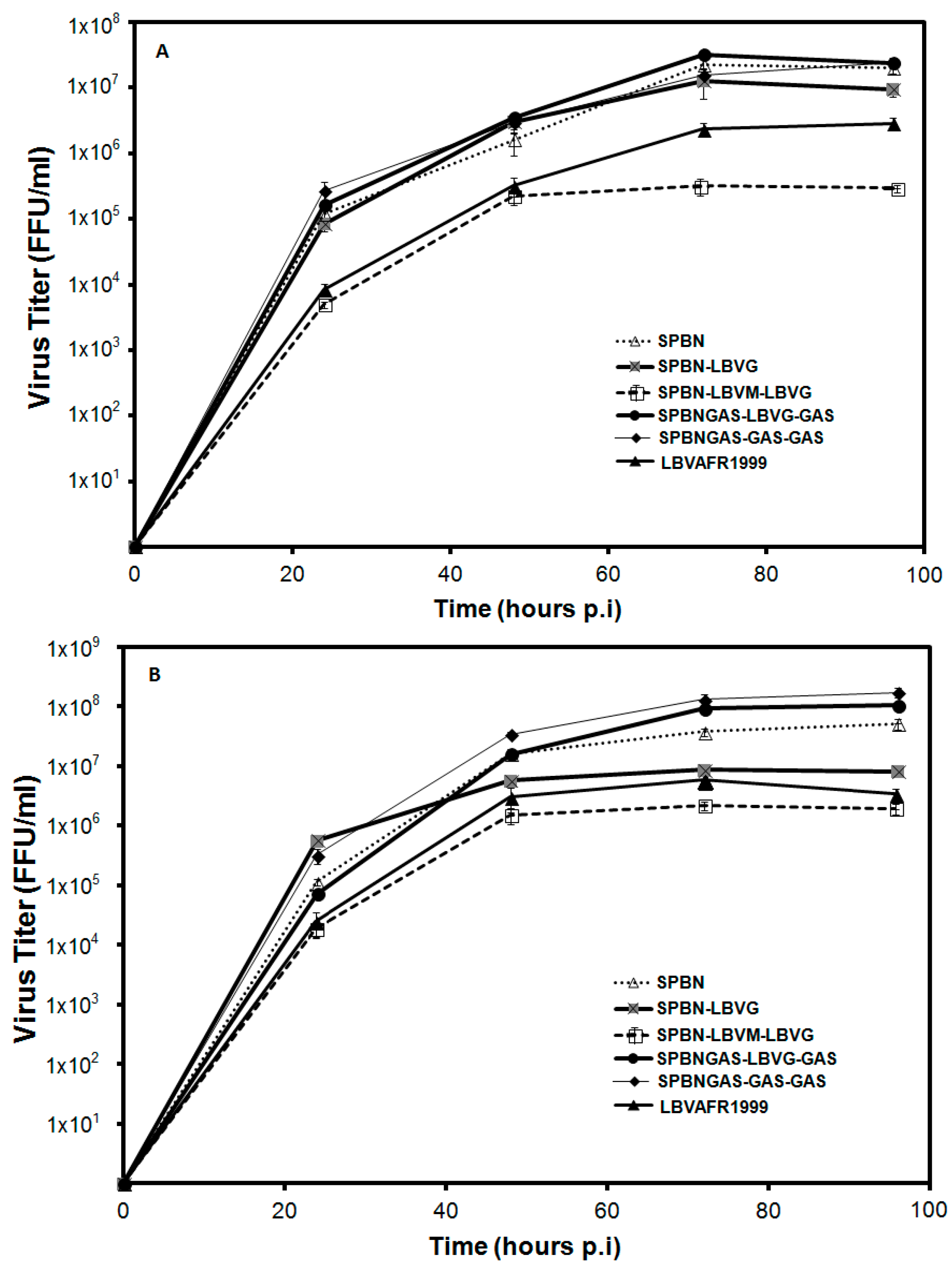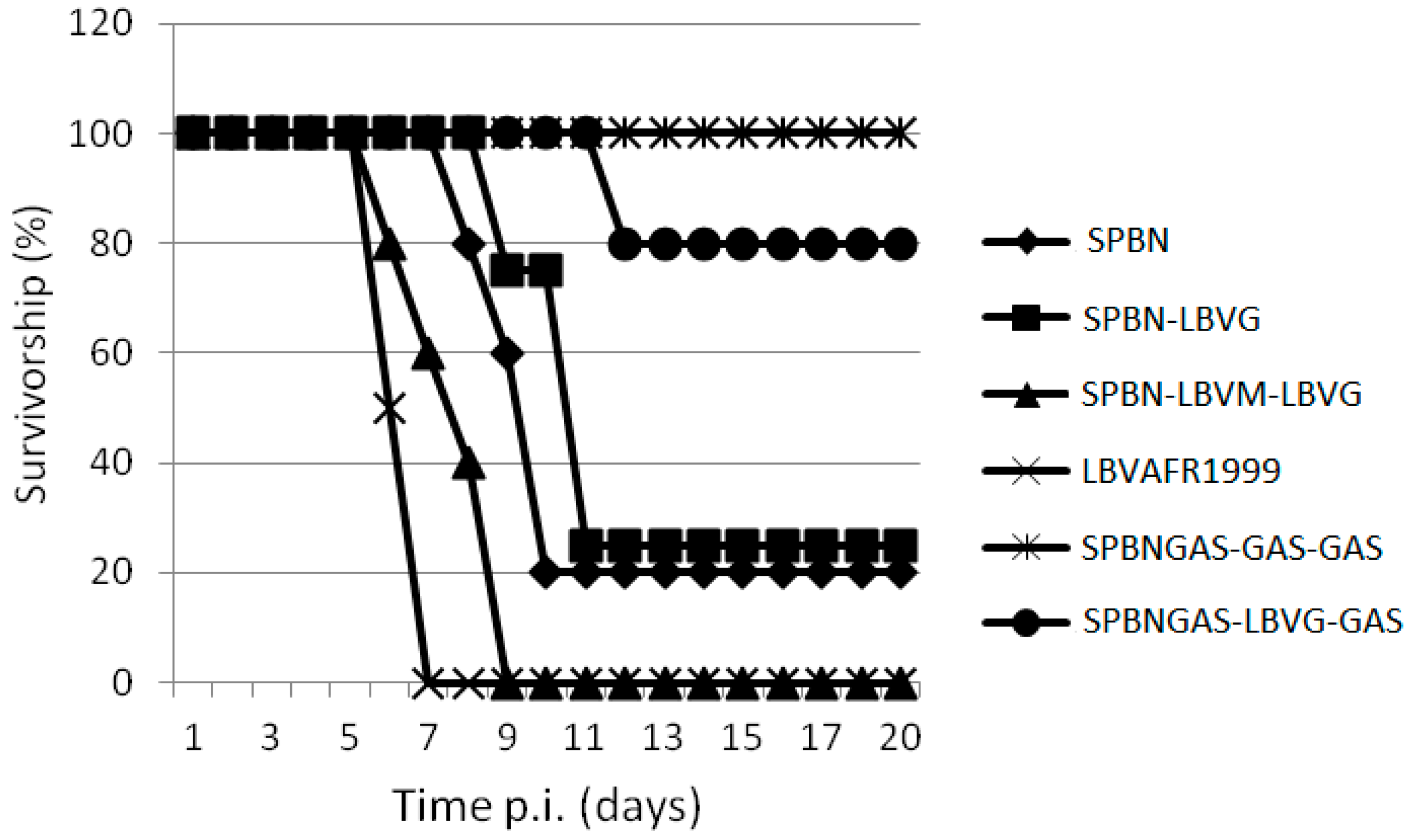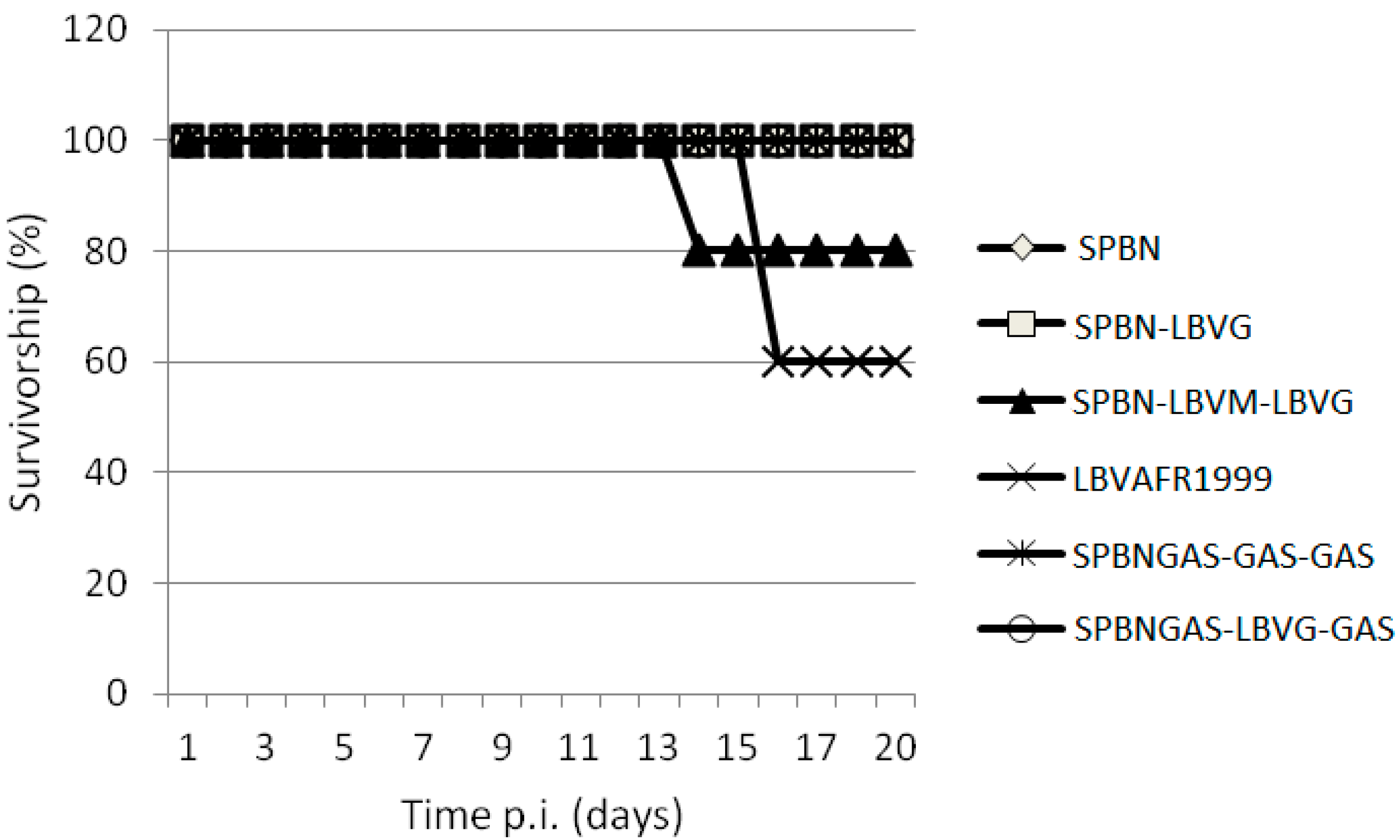Pathogenicity and Immunogenicity of Recombinant Rabies Viruses Expressing the Lagos Bat Virus Matrix and Glycoprotein: Perspectives for a Pan-Lyssavirus Vaccine
Abstract
:1. Introduction
2. Material and Methods
2.1. Virus Isolates, Recombinant Viruses and Cell Lines
2.2. Construction of the Recombinant Viruses
2.3. Rescue of the Recombinant Viruses
2.4. Amplification and Titration of the Rescued Recombinant Viruses
2.5. Lagos Bat Virus Glycoprotein Expression by the Recombinant Viruses
2.6. Single- and Multi-Step Growth Assays
2.7. Experimental Infections of Mice
2.8. Rapid Fluorescent Focus Inhibition Test (RFFIT)
2.9. Statistical Analyses
3. Results
3.1. Confirmation of LBV G Protein Expression by Recombinant Viruses
3.2. In Vitro Growth of Recombinant Viruses in MNA Cells
3.3. Pathogenicity of Recombinant Viruses in Mice
3.4. VNA Response of Mice Vaccinated with SPBNGAS-LBVG-GAS
4. Discussion
Acknowledgments
Author Contributions
Conflicts of Interest
References
- Dietzgen, R.G.; Calisher, C.H.; Kurath, G.; Kuzmin, I.V.; Rodriguez, L.L.; Stone, D.M.; Tesh, R.B.; Tordo, N.; Walker, P.J.; Wetzel, T. Family Rhabdoviridae. In Virus Taxonomy: Ninth Report of the International Committee on Taxonomy of Viruses; King, A.M.Q., Adams, M.J., Carstens, E.B., Lefkowitz, E.J., Eds.; Elsevier: San Diego, CA, USA, 2011; pp. 654–681. [Google Scholar]
- Banyard, A.C.; Fooks, A.R. The impact of novel lyssavirus discovery. Mcrobiol. Aust. 2017, 38, 17–21. [Google Scholar] [CrossRef]
- ICTV. Available online: http://ictvonline.org/virusTaxonomy.asp/ (accessed on 15 June 2017).
- Markotter, W.; Kuzmin, I.; Rupprecht, C.; Nel, L. Phylogeny of Lagos bat virus: Challenges for lyssavirus taxonomy. Virus Res. 2008, 135, 10–21. [Google Scholar] [CrossRef] [PubMed]
- Swanepoel, R. Rabies. In Infectious Diseases of Livestock: With Special Reference to Southern Africa; Coetzer, J.A.W., Tustin, R.C., Eds.; Oxford University Press: Cape Town, South Africa, 2004; pp. 1123–1182. [Google Scholar]
- Kuzmin, I.V.; Niezgoda, M.; Franka, R.; Agwanda, B.; Markotter, W.; Beagley, J.C.; Urazova, O.Y.; Breiman, R.F.; Rupprecht, C.E. Lagos bat virus in Kenya. J. Clin. Microbiol. 2008, 46, 1451–1461. [Google Scholar] [CrossRef] [PubMed]
- Mebatsion, T.; Cox, J.H.; Frost, J.W. Isolation and characterization of 115 street rabies virus isolates from Ethiopia by using monoclonal antibodies: Identification of 2 isolates as Mokola and Lagos bat viruses. J. Infect. Dis. 1992, 166, 972–977. [Google Scholar] [CrossRef] [PubMed]
- Markotter, W.; Van Eeden, C.; Kuzmin, I.; Rupprecht, C.; Paweska, J.; Swanepoel, R.; Fooks, A.; Sabeta, C.; Cliquet, F.; Nel, L. Epidemiology and pathogenicity of African bat lyssaviruses. Dev. Biol. 2008, 131, 317–325. [Google Scholar]
- Markotter, W.; Kuzmin, I.; Rupprecht, C.E.; Randles, J.; Sabeta, C.T.; Wandeler, A.I.; Nel, L.H. Isolation of Lagos bat virus from water mongoose. Emerg. Infect. Dis. 2006, 12, 1913. [Google Scholar] [CrossRef] [PubMed]
- Kgaladi, J.; Nel, L.H.; Markotter, W. Comparison of pathogenic domains of rabies and African rabies-related lyssaviruses and pathogenicity observed in mice. Onderstepoort J. Vet. Res. 2013, 80, 1–13. [Google Scholar] [CrossRef] [PubMed]
- Markotter, W.; Kuzmin, I.V.; Rupprecht, C.E.; Nel, L.H. Lagos bat virus virulence in mice inoculated by the peripheral route. Epidemiol. Infect. 2009, 137, 1155–1162. [Google Scholar] [CrossRef] [PubMed]
- Faber, M.; Pulmanausahakul, R.; Nagao, K.; Prosniak, M.; Rice, A.B.; Koprowski, H.; Schnell, M.J.; Dietzschold, B. Identification of viral genomic elements responsible for rabies virus neuroinvasiveness. Proc. Natl. Acad. Sci. USA 2004, 101, 16328–16332. [Google Scholar] [CrossRef] [PubMed]
- Pulmanausahakul, R.; Li, J.; Schnell, M.J.; Dietzschold, B. The glycoprotein and the matrix protein of rabies virus affect pathogenicity by regulating viral replication and facilitating cell-to-cell spread. J. Virol. 2008, 82, 2330–2338. [Google Scholar] [CrossRef] [PubMed]
- Tao, L.; Ge, J.; Wang, X.; Zhai, H.; Hua, T.; Zhao, B.; Kong, D.; Yang, C.; Chen, H.; Bu, Z. Molecular basis of neurovirulence of flury rabies virus vaccine strains: Importance of the polymerase and the glycoprotein R333Q mutation. J. Virol. 2010, 84, 8926–8936. [Google Scholar] [CrossRef] [PubMed]
- Shimizu, K.; Ito, N.; Mita, T.; Yamada, K.; Hosokawa-Muto, J.; Sugiyama, M.; Minamoto, N. Involvement of nucleoprotein, phosphoprotein, and matrix protein genes of rabies virus in virulence for adult mice. Virus Res. 2007, 123, 154–160. [Google Scholar] [CrossRef] [PubMed]
- Dietzschold, B.; Schnell, M.J. New approaches to the development of live attenuated rabies vaccines. Hybrid. Hybridomics. 2002, 21, 129–134. [Google Scholar] [CrossRef] [PubMed]
- Morimoto, K.; Foley, H.D.; McGettigan, J.P.; Schnell, M.J.; Dietzschold, B. Reinvestigation of the role of the rabies virus glycoprotein in viral pathogenesis using a reverse genetics approach. J. Neurovirol. 2000, 6, 373–381. [Google Scholar] [CrossRef] [PubMed]
- Marston, D.A.; McElhinney, L.M.; Banyard, A.C.; Horton, D.L.; Núñez, A.; Koser, M.L.; Schnell, M.J.; Fooks, A.R. Interspecies protein substitution to investigate the role of the lyssavirus glycoprotein. J. Gen. Virol. 2013, 94, 284–292. [Google Scholar] [CrossRef] [PubMed]
- Masatani, T.; Ito, N.; Shimizu, K.; Ito, Y.; Nakagawa, K.; Sawaki, Y.; Koyama, H.; Sugiyama, M. Rabies virus nucleoprotein functions to evade activation of the RIG-I-mediated antiviral response. J. Virol. 2010, 84, 4002–4012. [Google Scholar] [CrossRef] [PubMed]
- Ito, N.; Takayama, M.; Yamada, K.; Sugiyama, M.; Minamoto, N. Rescue of rabies virus from cloned cDNA and identification of the pathogenicity-related gene: Glycoprotein gene is associated with virulence for adult mice. J. Virol. 2001, 75, 9121–9128. [Google Scholar] [CrossRef] [PubMed]
- Langevin, C.; Jaaro, H.; Bressanelli, S.; Fainzilber, M.; Tuffereau, C. Rabies virus glycoprotein (RVG) is a trimeric ligand for the N-terminal cysteine-rich domain of the mammalian p75 neurotrophin receptor. J. Biol. Chem. 2002, 277, 37655–37662. [Google Scholar] [CrossRef] [PubMed]
- Tuffereau, C.; Benejean, J.; Blondel, D.; Kieffer, B.; Flamand, A. Low-affinity nerve-growth factor receptor (P75NTR) can serve as a receptor for rabies virus. EMBO J. 1998, 17, 7250–7259. [Google Scholar] [CrossRef] [PubMed]
- Lentz, T.L.; Burrage, T.G.; Smith, A.L.; Crick, J.; Tignor, G.H. Is the acetylcholine receptor a rabies virus receptor? Science 1982, 215, 182–184. [Google Scholar] [CrossRef] [PubMed]
- Thoulouze, M.-I.; Lafage, M.; Schachner, M.; Hartmann, U.; Cremer, H.; Lafon, M. The neural cell adhesion molecule is a receptor for rabies virus. J. Virol. 1998, 72, 7181–7190. [Google Scholar] [PubMed]
- Morimoto, K.; Hooper, D.C.; Spitsin, S.; Koprowski, H.; Dietzschold, B. Pathogenicity of different rabies virus variants inversely correlates with apoptosis and rabies virus glycoprotein expression in infected primary neuron cultures. J. Virol. 1999, 73, 510–518. [Google Scholar] [PubMed]
- Kassis, R.; Larrous, F.; Estaquier, J.; Bourhy, H. Lyssavirus matrix protein induces apoptosis by a TRAIL-dependent mechanism involving caspase-8 activation. J. Virol. 2004, 78, 6543–6555. [Google Scholar] [CrossRef] [PubMed]
- Préhaud, C.; Lay, S.; Dietzschold, B.; Lafon, M. Glycoprotein of nonpathogenic rabies viruses is a key determinant of human cell apoptosis. J. Virol. 2003, 77, 10537–10547. [Google Scholar] [CrossRef] [PubMed]
- Genz, B.; Nolden, T.; Negatsch, A.; Teifke, J.-P.; Conzelmann, K.-K.; Finke, S. Chimeric rabies viruses for trans-species comparison of lyssavirus glycoprotein ectodomain functions in virus replication and pathogenesis. Berl. Munch. Tierarztl. Wochenschr. 2012, 9, 219–227. [Google Scholar]
- Finke, S.; Granzow, H.; Hurst, J.; Pollin, R.; Mettenleiter, T.C. Intergenotypic replacement of lyssavirus matrix proteins demonstrates the role of lyssavirus M proteins in intracellular virus accumulation. J. Virol. 2010, 84, 1816–1827. [Google Scholar] [CrossRef] [PubMed]
- Badrane, H.; Bahloul, C.; Perrin, P.; Tordo, N. Evidence of two Lyssavirus phylogroups with distinct pathogenicity and immunogenicity. J. Virol. 2001, 75, 3268–3276. [Google Scholar] [CrossRef] [PubMed]
- Lafon, M.; Bourhy, H.; Sureau, P. Immunity against the European bat rabies (Duvenhage) virus induced by rabies vaccines: An experimental study in mice. Vaccine 1988, 6, 362–368. [Google Scholar] [CrossRef]
- Malerczyk, C.; Selhorst, T.; Tordo, N.; Moore, S.; Müller, T. Antibodies induced by vaccination with purified chick embryo cell culture vaccine (PCECV) cross-neutralize non-classical bat lyssavirus strains. Vaccine 2009, 27, 5320–5325. [Google Scholar] [CrossRef] [PubMed]
- Hanlon, C.A.; Kuzmin, I.V.; Blanton, J.D.; Weldon, W.C.; Manangan, J.S.; Rupprecht, C.E. Efficacy of rabies biologics against new lyssaviruses from Eurasia. Virus Res. 2005, 111, 44–54. [Google Scholar] [CrossRef] [PubMed]
- Jallet, C.; Jacob, Y.; Bahloul, C.; Drings, A.; Desmezieres, E.; Tordo, N.; Perrin, P. Chimeric lyssavirus glycoproteins with increased immunological potential. J. Virol. 1999, 73, 225–233. [Google Scholar] [PubMed]
- Brookes, S.; Parsons, G.; Johnson, N.; McElhinney, L.; Fooks, A. Rabies human diploid cell vaccine elicits cross-neutralising and cross-protecting immune responses against European and Australian bat lyssaviruses. Vaccine 2005, 23, 4101–4109. [Google Scholar] [CrossRef] [PubMed]
- Nel, L.H. Vaccines for lyssaviruses other than rabies. Expert Rev. Vaccines 2005, 4, 533–540. [Google Scholar] [CrossRef] [PubMed]
- Horton, D.L.; Banyard, A.C.; Marston, D.A.; Wise, E.; Selden, D.; Nunez, A.; Hicks, D.; Lembo, T.; Cleaveland, S.; Peel, A.J. Antigenic and genetic characterization of a divergent African virus, Ikoma lyssavirus. J. Gen. Virol. 2014, 95, 1025–1032. [Google Scholar] [CrossRef] [PubMed]
- Kuzmin, I.V.; Mayer, A.E.; Niezgoda, M.; Markotter, W.; Agwanda, B.; Breiman, R.F.; Rupprecht, C.E. Shimoni bat virus, a new representative of the Lyssavirus genus. Virus Res. 2010, 149, 197–210. [Google Scholar] [CrossRef] [PubMed]
- Faber, M.; Pulmanausahakul, R.; Hodawadekar, S.S.; Spitsin, S.; McGettigan, J.P.; Schnell, M.J.; Dietzschold, B. Overexpression of the rabies virus glycoprotein results in enhancement of apoptosis and antiviral immune response. J. Virol. 2002, 76, 3374–3381. [Google Scholar] [CrossRef] [PubMed]
- Faber, M.; Li, J.; Kean, R.B.; Hooper, D.C.; Alugupalli, K.R.; Dietzschold, B. Effective preexposure and postexposure prophylaxis of rabies with a highly attenuated recombinant rabies virus. Proc. Natl. Acad. Sci. USA 2009, 106, 11300–11305. [Google Scholar] [CrossRef] [PubMed]
- Hosokawa-Muto, J.; Ito, N.; Yamada, K.; Shimizu, K.; Sugiyama, M.; Minamoto, N. Characterization of recombinant rabies virus carrying double glycoprotein genes. Microbiol. Immunol. 2006, 50, 187–196. [Google Scholar] [CrossRef] [PubMed]
- Tao, L.; Ge, J.; Wang, X.; Wen, Z.; Zhai, H.; Hua, T.; Zhao, B.; Kong, D.; Yang, C.; Bu, Z. Generation of a recombinant rabies Flury LEP virus carrying an additional G gene creates an improved seed virus for inactivated vaccine production. Virol. J. 2011, 8, 1–7. [Google Scholar] [CrossRef] [PubMed]
- Cenna, J.; Hunter, M.; Tan, G.S.; Papaneri, A.B.; Ribka, E.P.; Schnell, M.J.; Marx, P.A.; McGettigan, J.P. Replication-deficient rabies virus–based vaccines are safe and immunogenic in mice and monhuman primates. J. Infect. Dis. 2009, 200, 1251–1260. [Google Scholar] [CrossRef] [PubMed]
- Faul, E.J.; Wanjalla, C.N.; McGettigan, J.P.; Schnell, M.J. Interferon-β expressed by a rabies virus-based HIV-1 vaccine vector serves as a molecular adjuvant and decreases pathogenicity. Virology 2008, 382, 226–238. [Google Scholar] [CrossRef] [PubMed]
- Wen, Y.; Wang, H.; Wu, H.; Yang, F.; Tripp, R.A.; Hogan, R.J.; Fu, Z.F. Rabies virus expressing dendritic cell-activating molecules enhances the innate and adaptive immune response to vaccination. J. Virol. 2011, 85, 1634–1644. [Google Scholar] [CrossRef] [PubMed]
- Zhao, L.; Toriumi, H.; Wang, H.; Kuang, Y.; Guo, X.; Morimoto, K.; Fu, Z.F. Expression of MIP-1α (CCL3) by a recombinant rabies virus enhances its immunogenicity by inducing innate immunity and recruiting dendritic cells and B cells. J. Virol. 2010, 84, 9642–9648. [Google Scholar] [CrossRef] [PubMed]
- Pulmanausahakul, R.; Faber, M.; Morimoto, K.; Spitsin, S.; Weihe, E.; Hooper, D.C.; Schnell, M.J.; Dietzschold, B. Overexpression of cytochrome C by a recombinant rabies virus attenuates pathogenicity and enhances antiviral immunity. J. Virol. 2001, 75, 10800–10807. [Google Scholar] [CrossRef] [PubMed]
- Faber, M.; Faber, M.-L.; Li, J.; Preuss, M.A.; Schnell, M.J.; Dietzschold, B. Dominance of a nonpathogenic glycoprotein gene over a pathogenic glycoprotein gene in rabies virus. J. Virol. 2007, 81, 7041–7047. [Google Scholar] [CrossRef] [PubMed]
- Faber, M.; Faber, M.-L.; Papaneri, A.; Bette, M.; Weihe, E.; Dietzschold, B.; Schnell, M.J. A single amino acid change in rabies virus glycoprotein increases virus spread and enhances virus pathogenicity. J. Virol. 2005, 79, 14141–14148. [Google Scholar] [CrossRef] [PubMed]
- Schnell, M.J.; Mebatsion, T.; Conzelmann, K.-K. Infectious rabies viruses from cloned cDNA. EMBO J. 1994, 13, 4195. [Google Scholar] [PubMed]
- ProMED-mail. Rabies, bat-France. ProMED-mail 199990813.1401. Available online: http://www.promedmail.org (accessed on 15 June 2017).
- Aubert, F.A. Rabies in individual countries: France. Rabies Bulletin Europe [serial on the internet]. Available online: http://www.who-rabiesbulletin.org/ (accessed on 15 June 2017).
- Sato, M.; Maeda, N.; Yoshida, H.; Urade, M.; Saito, S.; Miyazaki, T.; Shibata, T.; Watanabe, M. Plaque formation of herpes virus hominis type 2 and rubella virus in variants isolated from the colonies of BHK21/WI-2 cells formed in soft agar. Arch. Virol. 1977, 53, 269–273. [Google Scholar] [CrossRef] [PubMed]
- Dean, D.J.; Abelseth, M.K.; Atanasiu, P. The fluorescent antibody test: p 89–85. In Laboratory Techniques in Rabies, 4th ed.; Meslin, F.-X., Kaplan, M.M., Koprowski, H., Eds.; World Health Organization: Geneva, Switzerland, 1996; pp. 157–174. [Google Scholar]
- Reed, L.J.; Muench, H. A simple method of estimating fifty per cent endpoints. Am. J. Epidemiol. 1938, 27, 493–497. [Google Scholar] [CrossRef]
- Smith, J.S.; Yager, P.A.; Baer, G.M. A rapid fluorescent focus inhibition test (RFFIT) for determining rabies virus neutralizing antibody. In Laboratory Techniques in Rabies; Meslin, F.-X., Kaplan, M.M., Koprowski, H., Eds.; World Health Organization: Geneva, Switzerland, 1996; pp. 189–192. [Google Scholar]
- McCulloch, S.D. Barcoding of South African bat species and evaluation of their natural exposure to lyssaviruses. Master’s Thesis, University of Pretoria, Pretoria, South Africa, 2013. [Google Scholar]
- Mebatsion, T.; Schnell, M.J.; Conzelmann, K.-K. Mokola virus glycoprotein and chimeric proteins can replace rabies virus glycoprotein in the rescue of infectious defective rabies virus particles. J. Virol. 1995, 69, 1444–1451. [Google Scholar] [PubMed]
- Cox, J.H.; Dietzschold, B.; Schneider, L. Rabies virus glycoprotein. II. Biological and serological characterization. Infect. Immun. 1977, 16, 754–759. [Google Scholar] [PubMed]
- Dietzschold, B.; Wang, H.; Rupprecht, C.E.; Celis, E.; Tollis, M.; Ertl, H.; Heber-Katz, E.; Koprowski, H. Induction of protective immunity against rabies by immunization with rabies virus ribonucleoprotein. Proc. Natl. Acad. Sci. USA 1987, 84, 9165–9169. [Google Scholar] [CrossRef] [PubMed]
- Mebatsion, T.; König, M.; Conzelmann, K.-K. Budding of rabies virus particles in the absence of the spike glycoprotein. Cell 1996, 84, 941–951. [Google Scholar] [CrossRef]
- Etessami, R.; Conzelmann, K.-K.; Fadai-Ghotbi, B.; Natelson, B.; Tsiang, H.; Ceccaldi, P.-E. Spread and pathogenic characteristics of a G-deficient rabies virus recombinant: An in vitro and in vivo study. J. Gen. Virol. 2000, 81, 2147–2153. [Google Scholar] [CrossRef] [PubMed]
- Mebatsion, T.; Weiland, F.; Conzelmann, K.-K. Matrix protein of rabies virus is responsible for the assembly and budding of bullet-shaped particles and interacts with the transmembrane spike glycoprotein G. J. Virol. 1999, 73, 242–250. [Google Scholar] [PubMed]
- Morimoto, K.; McGettigan, J.P.; Foley, H.D.; Hooper, D.C.; Dietzschold, B.; Schnell, M.J. Genetic engineering of live rabies vaccines. Vaccine 2001, 19, 3543–3551. [Google Scholar] [CrossRef]
- Weyer, J.; Kuzmin, I.V.; Rupprecht, C.E.; Nel, L.H. Cross-protective and cross-reactive immune responses to recombinant vaccinia viruses expressing full-length lyssavirus glycoprotein genes. Epidemiol. Infect. 2008, 136, 670–678. [Google Scholar] [CrossRef] [PubMed]
- Bahloul, C.; Jacob, Y.; Tordo, N.; Perrin, P. DNA-based immunization for exploring the enlargement of immunological cross-reactivity against the lyssaviruses. Vaccine 1998, 16, 417–425. [Google Scholar] [CrossRef]
- Dietzschold, B.; Kao, M.; Zheng, Y.M.; Chen, Z.Y.; Maul, G.; Fu, Z.F.; Rupprecht, C.E.; Koprowski, H. Delineation of putative mechanisms involved in antibody-mediated clearance of rabies virus from the central nervous system. Proc. Natl. Acad. Sci. USA 1992, 89, 7252–7256. [Google Scholar] [CrossRef] [PubMed]




| Primer | Sequence in 5′ to 3′ Direction * | Gene Targeted |
|---|---|---|
| LBVXmaI | TATCCCCCCGGGAAGATGAGTCAATTGTTCTCAACC | G gene |
| LBVPacI (to be used with LBVXmaI) | CCGACCTTAATTAAGGTTAGACACTTGATGTCTCTTTATATG | G gene |
| LBVEcoRIBsiWI | GCAGAATTCCGTACGAAGATGAGTCAATTGTTCTCAACCTTCAT | G gene |
| LBVXbaIAsiSI (to be used with LBVEcoRIBsiWI) | TAATCTAGAGCGATCGCCGTTTAGACACTTGATGTCTCTTTATATGA | G gene |
| LBV1319F (binds on position 1319 on the open reading frame of the LBVAFR1999 G gene, EF547432) | CGACTTCGTCGATGTCCACATGCC | G gene |
| LBV255R (binds on position 255 on the open reading frame of the LBVAFR1999 G gene, EF547432) | GTTGGTGTATGTGACTGCCTCG | G gene |
| RabC2121F (to be used with LBV255R [binds on position 2121 on the complete genome of RABV, NC_001542]) | CAGTGGAGGCTGAGATCGCTC | M gene |
| Challenge Virus * | Virus Neutralization Index (VNI) # Anti-LBV Serum Dilution | |||
|---|---|---|---|---|
| 1:10 | 1:100 | 1:400 | 1:1000 | |
| LBV (LBVAFR1999) (positive control) | 103 | 103 | 103 | 100 |
| SPBN (negative control) | 100 | 100 | 100 | 100 |
| SPBN-LBVG | 103 | 103 | 103 | 100 |
| SPBN-LBVM-LBVG | 103 | 103 | 103 | 100 |
| SPBNGAS-LBVG-GAS | 103 | 103 | 100 | 100 |
| Virus | Mean Incubation Period, s.d. and Range of Incubation Periods (Days) | Number of Mice that Died per Group of Mice Inoculated i.c. | |
|---|---|---|---|
| Mean and s.d. | Range | ||
| LBVAFR1999 | 6.5 ± 0.58 | 6–7 | 4/4 (100%) |
| SPBN | 9.25 ± 0.96 | 8–10 | 4/5 (80%) |
| SPBN-LBVG | 10.33 ± 1.15 | 9–11 | 3/4 (75%) |
| SPBN-LBVM-LBVG | 7.8 ± 1.30 | 6–9 | 5/5 (100%) |
| SPBNGAS-GAS-GAS | - | - | 0/5 (0%) |
| SPBNGAS-LBVG-GAS | 12 ± NA | 12 | 1/5 (20%) |
| Mouse No. | Neutralization Dilution * (RABV-CVS) # | Neutralization Dilution * (DUVVSA2006) # | Neutralization Dilution * (LBVAFR1999) # | Neutralization Dilution * (MOKV252/97) # | ||||
|---|---|---|---|---|---|---|---|---|
| Day 13 | Day 28 | Day 13 | Day 28 | Day 13 | Day 28 | Day 13 | Day 28 | |
| Mouse 1 | 1:400 | 1:2500 | 1:160 | 1:1000 | 1:160 | 1:1000 | 1:65 | 1:400 |
| Mouse 2 | 1:160 | 1:2500 | 1:65 | 1:400 | 1:65 | 1:400 | 1:10 | 1:160 |
| Mouse 3 | 1:1000 | 1:6100 | 1:400 | 1:2500 | 1:400 | 1:6100 | 1:160 | 1:1000 |
| Mouse 4 | 1:400 | 1:1000 | 1:400 | 1:1000 | 1:160 | 1:400 | 1:65 | 1:400 |
| Mouse 5 | 1:400 | 1:2500 | 1:160 | 1:1000 | 1:65 | 1:400 | 1:25 | 1:400 |
| Mouse 6 | 1:400 | 1:1000 | 1:160 | 1:1000 | 1:160 | 1:1000 | 1:65 | 1:400 |
| Mouse 7 | 1:160 | 1:1000 | 1:65 | 1:1000 | 1:65 | 1:400 | 1:25 | 1:400 |
| Mouse 8 | 1:400 | 1:2500 | 1:400 | 1:2500 | 1:160 | 1:1000 | 1:65 | 1:400 |
| Mouse 9 | 1:400 | 1:2500 | 1:400 | 1:1000 | 1:160 | 1:1000 | 1:160 | 1:1000 |
| Mouse 10 | 1:1000 | 1:6100 | 1:400 | 1:6100 | 1:400 | 1:2500 | 1:160 | 1:1000 |
| Range ~ | 1:160–1:1000 | 1:1000–6100 | 1:65–1:400 | 1:400–1:6100 | 1:65–1:400 | 1:400–1:6100 | 1:10–1:160 | 1:400–1:1000 |
© 2017 by the authors. Licensee MDPI, Basel, Switzerland. This article is an open access article distributed under the terms and conditions of the Creative Commons Attribution (CC BY) license (http://creativecommons.org/licenses/by/4.0/).
Share and Cite
Kgaladi, J.; Faber, M.; Dietzschold, B.; Nel, L.H.; Markotter, W. Pathogenicity and Immunogenicity of Recombinant Rabies Viruses Expressing the Lagos Bat Virus Matrix and Glycoprotein: Perspectives for a Pan-Lyssavirus Vaccine. Trop. Med. Infect. Dis. 2017, 2, 37. https://doi.org/10.3390/tropicalmed2030037
Kgaladi J, Faber M, Dietzschold B, Nel LH, Markotter W. Pathogenicity and Immunogenicity of Recombinant Rabies Viruses Expressing the Lagos Bat Virus Matrix and Glycoprotein: Perspectives for a Pan-Lyssavirus Vaccine. Tropical Medicine and Infectious Disease. 2017; 2(3):37. https://doi.org/10.3390/tropicalmed2030037
Chicago/Turabian StyleKgaladi, Joe, Milosz Faber, Bernhard Dietzschold, Louis H. Nel, and Wanda Markotter. 2017. "Pathogenicity and Immunogenicity of Recombinant Rabies Viruses Expressing the Lagos Bat Virus Matrix and Glycoprotein: Perspectives for a Pan-Lyssavirus Vaccine" Tropical Medicine and Infectious Disease 2, no. 3: 37. https://doi.org/10.3390/tropicalmed2030037





